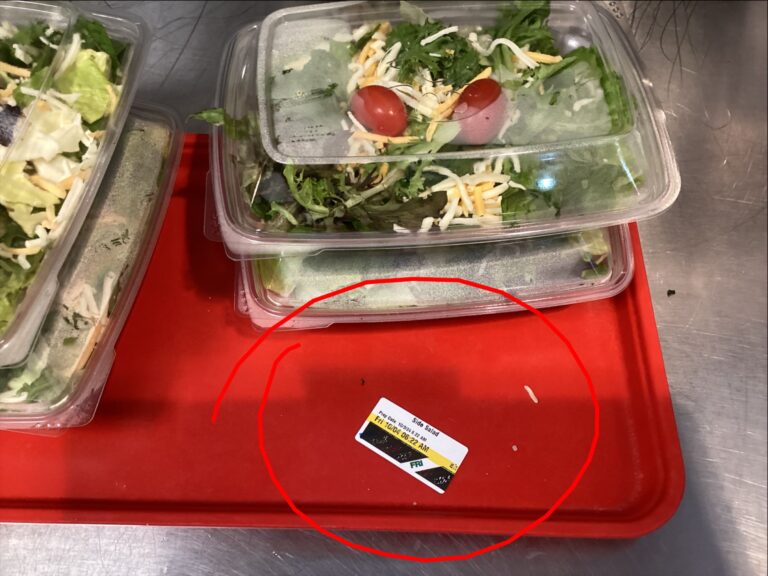Tip Jar #5: Solving the Problem of Improper Storage of Deliveries
In a fast-paced environment, especially in the food and service industry, deliveries are a constant. Yet, too often, they’re left sitting out for hours, waiting for someone to notice and properly store them. This oversight can lead to serious food safety risks, reputational damage, and, in the worst cases, fines or penalties from health inspectors. A delivery sitting unattended might seem like a small issue, but it’s a visible sign of deeper problems with food safety practices and accountability in the workplace.

When employees cite reasons like “I didn’t know it was there” or “I thought someone else would do it,” it’s clear that the team lacks clear direction on delivery handling. To tackle this problem effectively, businesses need to establish clear procedures, instill a culture of food safety, and provide the right tools to help team members consistently meet safety standards. Here’s a practical guide to ensure that deliveries are handled safely and efficiently, every time.
Key Takeaways
- Establish Clear Procedures: Outline clear, accessible guidelines for delivery handling and storage.
- Create a Food Safety Culture: Emphasize accountability and make food safety a core team responsibility.
- Use Tools and Checklists: Provide job aids like checklists to help team members follow food safety practices.
- Leadership Oversight: Ensure leaders prioritize and reinforce food safety standards over short-term gains.
The Importance of Food Safety Requirements
Food safety is the cornerstone of any operation handling food items. Unattended deliveries can quickly lead to products being stored at unsafe temperatures, increasing the risk of spoilage or contamination. Health inspectors are keenly aware of this, as are customers who notice slip-ups in hygiene or storage. Food safety standards are in place to protect both the business and its patrons, ensuring everyone’s health and maintaining trust in the brand.
For every business, food safety begins with knowledge. Each team member should understand the risks involved when a delivery isn’t stored correctly and recognize the potential repercussions. Training and clear communication on these standards build a strong foundation for safe delivery storage practices.
Proper Procedures for Delivery Execution
To avoid mishandled deliveries, clear protocols for delivery handling and storage should be in place. When a delivery arrives, employees should know exactly what to do: check the items against the order list, confirm they meet safety requirements, and promptly move them to appropriate storage areas.
Steps for Proper Delivery Execution:
- Inspect the Delivery: Verify the items received match the delivery slip and meet food safety standards.
- Assign Immediate Responsibility: Designate a specific team member to be responsible for handling and storing the delivery as soon as it arrives.
- Store in Correct Location: Ensure every item goes to its proper storage, whether that’s refrigerated, frozen, or dry storage.
- Confirm and Document: Use a checklist or log to track that each delivery has been properly stored.
Identifying Proper Storage Locations for Products
Not all products are stored in the same conditions. Knowing where each item belongs helps keep food fresh and reduces spoilage risks. Here’s a quick breakdown:
- Refrigerated Items: For perishables like dairy or meats, immediately store them in the fridge.
- Frozen Items: Place frozen goods directly in the freezer to avoid any thawing or temperature fluctuations.
- Dry Storage: Shelf-stable products go in a dry, cool area away from sunlight and moisture.
It’s crucial for every employee to understand which items go where, and training should cover storage requirements for various types of products.
Establishing Store Policies for Product Delivery
A standard set of policies around product delivery can remove guesswork, ensuring consistent food safety practices. These policies should outline clear roles and responsibilities: for example, the opener might handle deliveries during their shift, or a designated team member could manage deliveries based on arrival times. The policies should also detail what actions to take if the team is short-staffed or if there’s a space limitation in storage.
Sample Delivery Policy Checklist:
- Who is responsible for each part of the delivery process?
- When should deliveries be checked and stored?
- What should team members do if storage space is an issue?
Assigning Responsibility for Food Safety
Food safety isn’t one person’s responsibility—it’s a shared commitment. Every team member should feel accountable for maintaining the standards that protect both customers and coworkers. Creating this culture means regular communication from leadership about the importance of food safety, plus ongoing training to keep standards top of mind.
Leaders should also lead by example. By showing a commitment to food safety, managers can inspire employees to take pride in maintaining these standards, even if it means sacrificing a little time or convenience.
Solutions to Enforce Food Safety and Delivery Storage Standards
Building a reliable food safety culture takes both proactive steps and supporting tools. Here are some practical methods:
- Documented Procedures: Written guidelines on food safety protocols help ensure everyone knows what’s expected. These procedures should be easily accessible and regularly reviewed.
- Job Aids and Checklists: Providing tools like checklists and step-by-step guides helps employees consistently follow procedures without skipping essential steps.
- Daily Routines: Routine checks, like morning walkthroughs, reinforce the importance of proper delivery handling and allow for quick corrections if anything’s out of place.
- Leadership Support: Leaders need to reinforce that food safety is non-negotiable. This may require pausing to fix an issue instead of rushing to serve customers or clear orders, but it’s an investment in long-term safety and success.
Conclusion
Ensuring proper delivery storage and food safety is a collective effort. With clear guidelines, a supportive culture, and practical tools, every team member can contribute to maintaining high food safety standards. It’s about creating an environment where everyone understands their role in keeping customers and coworkers safe. By prioritizing these practices, your business not only meets regulatory standards but also builds trust with customers—trust that will support your brand’s reputation and future success.






